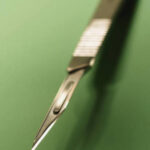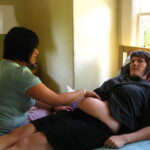Many women’s biggest fear during childbirth is tearing in their perineum (the skin between the vagina and anus) as the baby crowns. But there are some things you or doctor/nurse/midwife can do to help preventing tearing in the perineum.
Why do Women Tear?
There’s a lot of debate about this in the birthing community. Some experts feel that women are designed to tear, just a little bit, as it helps us remember to take it easy after childbirth and not have sex too quickly.
What about the Episiotomy?
The episiotomy is a cut to the perineum that doctors used to do routinely. If you were born in the sixties and seventies, your mother probably had an episiotomy. In the past, doctors felt that an episiotomy would actually prevent tearing. It was also assumed that the repair work of a cut rather than a jagged tear would be easier. However, studies have found that episiotomies actually caused more tearing to the fragile perineal tissues. Think about your perineum as you would a piece of fabric. If you make a cut in a piece of fabric and then stretch it, further tearing occurs.
Many care providers have also found it easier to repair a tear than an episiotomy since tears occur around tissue fibers, rather than a cut straight through fibers. In general, tears also heal better than episiotomies.
Preventing Tearing
There are some things your care provider can do to prevent tearing as your baby crowns.
1) Use perineal massage. Perineal massage is exactly what it sounds like; it’s massage of the perineum as the baby crowns, to help promote stretching. Usually it’s done by the doctor, nurse or midwife. It can also give women with an epidural the spot to focus their pushing on. Some care providers recommend doing perineal massage in the weeks before childbirth to help with blood flow to the perineum. Check with your care provider to see if they recommend this.
2) Try warm compresses. Warm compresses pressed to the vaginal area during late pushing can also help prevent tearing. Many women without epidurals claim that this helps with any pain or burning as the perineum stretches. Talk to your care provider to see if they are willing to do this for your birth.
3) Ask about mineral oil. Mineral oil can also help prevent tearing as it helps the baby slip through the birth canal. Many birthing facilities offer this option as a part of their procedures. If your birthing facility does not have this option, be sure to ask if they’ll let you use mineral oil.
4) Listen to your care provider. Many care providers will help women prevent tearing as the baby crowns, by giving instructions about how to push. These care providers will recommend small pushes as the baby crowns to help the perineum stretch around the baby’s head.
With some management, you may find that you do not tear during your birth, or the damage to your perineum is minimal. Be sure to talk to your care provider about the above tips and to find out how they prevent perineal tearing.



